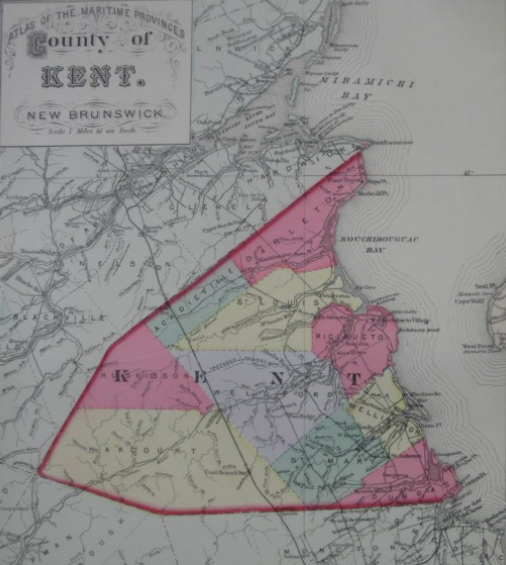
Cap-de-Richibucto
Before 1835, Richibucto Parish was part of Weldford Parish. Then, from 1835 to 1855, it became part of Saint-Louis Parish. In 1855, Richibucto Parish attained independent status as a separate entity.
The parish was named for the Richibucto River, which in turn is of Mi'kmaq origin.
Richibucto Parish is bounded on the:
- northwest by a line beginning on the northern line of Weldford Parish, near Aldouane Station Cross Road, then running northeasterly to a point on the northern boundary of the town of Richibucto about midway between Route 11 and Route 134, at the corner of a land grant, then northeasterly along the grant line to the rear of a grant on Northwest Branch, then southeasterly to the mouth of Thomas Brook, down Northwest Branch to Richibucto River, and out through Richibucto Harbour to the Northumberland Strait.
- east by the Northumberland Strait.
- south by the Chockpish River upstream as far as the mouth of the Rivière Chockpish-nord, then south 68º west to a point slightly west of East Branch Road
- west by a line running northwesterly to the mouth of Black Brook on the East Branch St. Nicholas River, then down the East Branch St. Nicholas and the St. Nicholas River to its mouth, then up the Richibucto River to the eastern line of Elsipogtog First Nation to its northernmost corner, then due west to the starting point.
In 2023, when the province of New Brunswick implemented local government reform, Five Rivers acquired part of Richibucto Parish.
_Web.png)
Harcourt
Harcourt Parish was formed in 1894. Before that, it was called Weldford. In 1869, the Intercolonial Railway was constructed, and in 1898, a railway station was built in Harcourt.
By 1898, was established as a farming community and lumbering settlement that had 7 stores, 2 hotels, 1 tannery, 1 sawmill, 1 hemlock bark extract factory, 1 carriage factory, 3 churches, and a population of 250.

Rexton
Situated on the scenic Richibucto River, the village now known as Rexton has a rich and layered history. It was originally inhabited by the Mi'kmaq First Nations, whose descendants continue to live in the region today—many in the nearby Elsipogtog First Nation (formerly known as the Big Cove Band).
In the 18th century, Acadian settlers established communities throughout the area, including Bouctouche, Miramichi, and Richibucto Village. English-speaking settlement began with Thomas Powel, who arrived in 1790. Significant colonization followed, particularly by English shipbuilders, Scottish merchants, and Irish immigrants—including Irish Protestants who came to work in the Jardine Shipbuilding Yards around 1819.
Land clearing and settlement intensified after a land survey around the 1820s by Mr. Layton in the Molus River area of Weldford Parish. As a result, many settlers were granted land, and the territory of the Elsipogtog First Nation was reduced to its current boundaries.
Two ships brought a large wave of Scottish settlers: the Dickies, captained by Simon Graham, and the Isabella, helmed by Captain Thomas Carruthers.
Throughout the 19th century, fishing, lumbering, and shipbuilding were thriving industries. In 1850, the first bridge across the Richibucto River was completed, greatly enhancing commerce and regional connectivity.
Originally called Kingston around 1825, the community was renamed Rexton in 1901, to avoid confusion with other locations named Kingston—especially Kingston in Kings County, New Brunswick.
On January 1, 2023, Rexton annexed parts of five local service districts to form the new Village of Five Rivers. Despite this administrative change, the name Rexton remains in official and local use.

Weldford
Weldford Parish was named in 1835 after John W. Weldon and John P. Ford who were members of the Legislative Assembly for Kent County at that time.
When local government reform was implemented on January 1, 2023, Weldford Parish was divided between the villages of Five Rivers and Nouvelle-Arcadie.
Kent County
Five Rivers is located in Kent County in eastern New Brunswick.
The county was established in 1826 from Carleton Parish. Originally, it was called Liverpool Parish, named about Robert Banks Jenkinson, the 2nd Earl of Liverpool (1770-1828) and prime minister of England from 1812-1827.

